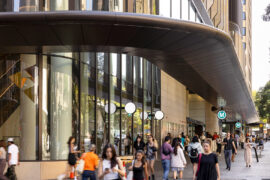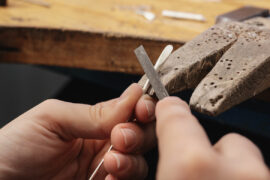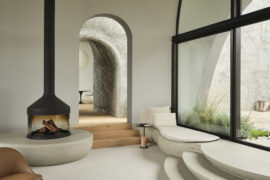Technē Architecture + Interior Design associate director, Sam Sempill, shares insights into hospitality design.

Tippy-Tay.
May 7th, 2024
Timothy Alouani-Roby: What has changed recently in hospitality design? More specifically, how has the pandemic affected hospitality design?
Sam Sempill: What we have observed within the hospitality and design sectors is that the market is ever-changing and dynamic. While the hospitality business was deeply affected economically by the pandemic and widespread lockdowns, by nature, people have continued to explore new possibilities and are constantly reframing themselves to the current condition.
Looking at it holistically, there’s a new layer of sensitivity to costs with inflation occurring locally and globally, alongside a changing expectation and efficiency of design. Fit-out prices have been significantly higher than in the recent past and we’re aware of our clients’ apprehension towards the current cost of construction.
At Technē, we’re taking out complexities and searching for ways to be clever on the spend. As we enter the halfway point of the 2020s, what I think we’ll see is a phase of a more contemporary and abstract approach to design as a departure from heavily ornamented recreations of the past.
Part of our dual-ended thinking, this abstract approach stems from our desire to express design in new ways going forward, but also as a response to the current economic condition and the cost implications for our clients. We’re beginning to refocus our palette with an abstract sensibility that still enriches our projects with a recognisable tactility, conviviality and experiential quality.

What trends are specific to Australia?
The idea of a trend shouldn’t exist in anything that we ever do as leading designers. While we can undoubtedly be influenced by them, we mustn’t be focusing on trends but, instead, respond to briefs with a bespoke sensibility and considered approach to the specifics of what we’re dealing with at the time. We always enjoy the process of creating new brands and concept narrative for our architectural project.
The concept for Tippy-Tay, for example, was conceived over the lockdowns and deliberately designed as a gateway to 1960s Italian Riviera. Highly detailed, layered and curated, we wanted to create an immersive haven that transports patrons away from the reality of strained international travelling and post-pandemic fatigue. While ‘transportative’ can anchor the brief for venues in the CBD, it is secondary for regional markets whose key focus is for the hub to attract and retain local customers.
As designers, we’re always searching for new ways of expressing or creating space. Similarly, we have found that hospitality operators and clients rarely look for a duplicate of another great project.

How do you balance heritage with contemporary needs?
Finding a way to balance the heritage value of a project with contemporary needs has been a really common area of work for us, since Technē’s establishment. When we take on adaptive reuse projects, we ensure that practical needs are met without compromising the original architectural details. Existing heritage features take centre stage and are expressed in ways that celebrate the elements that give the building its character. As opposed to spaces that are like blank canvases, where we have to completely invent a new narrative, heritage elements that are part of the architectural fabric have an inherent beauty and storytelling quality that can offer designers a creative ‘free kick.’
It’s also important to keep communications and intentions clear across all project stakeholders if there is a certain balance of contemporary with heritage that we’re looking to achieve. At the very start of every project, we’re talking clients through any heritage qualities and underscoring the brief with reminders that every choice should respond accordingly.
Related: AIR by OMA in Singapore

What can good design do for a restaurant?
Good design is crucial to a successful restaurant. At its foundation, it brings together all the functional and intangible elements — layout, flow, acoustics, lighting, ambience — and tailors them to support the business model, branding and offerings. Without thoughtful design, restaurants can easily fall flat no matter how much is invested. Good design means that the quantitative and qualitative aspects are given equal weight.
Our work in the hospitality space is always heroed by distinctive designs that connect with and are well-loved by patrons. At the heart of these designs, though, is a non-negotiable intention to first focus on getting functionality and efficiency working, so that everything comes together seamlessly, intuitively and practically.
We’ve been fortunate to collaborate on many enduring restaurants and brands like Movida, Tonka and Brunetti. By harmonising brand identity with functionality, innovation and great hospitality, good design can create memorable experiences and a sense of comfort, both front-of-house and back-of-house.

What are the things that can go horribly wrong with bad hospitality design?
Poor hospitality design can sabotage a venue in subtle but detrimental ways. Bad acoustics, harsh lighting, and uncomfortable furnishings quickly ruin the dining experience, and excessively stylish but impractical layouts can hamper workflow and operations. When there is a lack of synergy across floorplates, problems like inefficient flow and accidents often lead to overstaffing, employee burnout and unsustainable business models.
From a customer experience perspective, flawed acoustics is an especially silent killer for restaurants where patrons gather for conversation and socialising. Often, it becomes a struggle to converse in poor acoustic environments and becomes fatiguing for diners to compete with each other, much less the venue operators who are turning up the music to combat the ambience-draining chatter. When these issues aren’t addressed with practical design choices, connections between guests and staff can be lost due to excessive loudness.
It is crucial for our approach to consider every detail of the guest and staff experience. Thoughtful and intentional design examines all opportunities and challenges to create a seamless environment that is cohesive in elements, visually impressive and intuitively responsive to these needs.
Technē Architecture and Interior Design
techne.com.au
Photography
Tom Blachford, Shannon McGrath, Caitlin Mills





Hospitality meets luxury hotel design in this interview with W Hotels’ George Fleck
INDESIGN is on instagram
Follow @indesignlive
A searchable and comprehensive guide for specifying leading products and their suppliers
Keep up to date with the latest and greatest from our industry BFF's!
The new range features slabs with warm, earthy palettes that lend a sense of organic luxury to every space.

A longstanding partnership turns a historic city into a hub for emerging talent

‘Civic Vision | Foster + Partners’ is the first comprehensive exhibition of the practice’s work to be held in Australia, providing an in-depth look at its global portfolio of work since it was founded in 1967 by Norman Foster.

Richmond came alive for Saturday Indesign 2025 as showrooms, rooftops and laneways transformed into a celebration of design, creativity and connection.
The internet never sleeps! Here's the stuff you might have missed

With the inaugural Glenn Murcutt Symposium set to take place in Sydney in September 2025, Pritzker Prize-winner Francis Kéré receives the Murcutt Pin.

Leeton Pointon Architects and Allison Pye Interiors have been awarded as the winner of The Living Space at the INDE.Awards 2025 for their exceptional project House on a Hill. A refined and resilient multigenerational home, it exemplifies the balance of architecture, interior design and landscape in creating spaces of sanctuary and connection.

Grounded by the rich warmth of American white oak, The Standard’s newly opened restaurant, Kaya, redefines the classic dining convention through a tasteful fusion of biophilic design, mid-century modern sensibility and elevated whimsy.